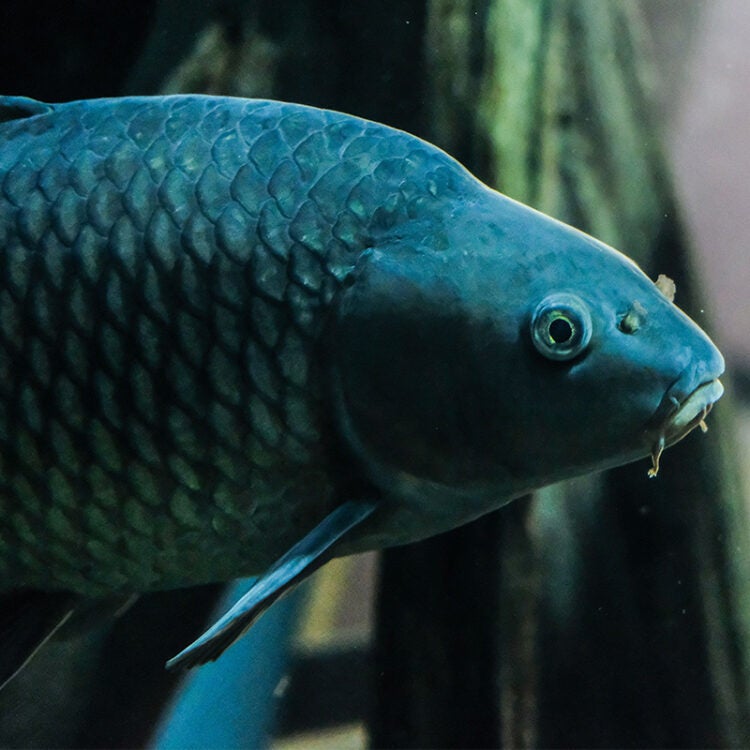-
Size
1 foot (31 cm) -
Diet
Aquatic plants and insects, insect larvae, small crustaceans, small fishes -
Range
Europe, Asia, North America -
Habitat
Slow flowing rivers and lakes
Physical Characteristics
- The common carp has a long retractable mouth with two fleshy barbels on each side of the upper jaw at the corner of the mouth. The rearmost barbel is larger.
- Coloration is gray to brassy olive above and golden yellow below, with clear to dusky fins. A large adult has red-orange caudal and anal fins. The scales are large.
- This fish can grow to approximately 4 feet (1.2 m) in length.
- Genetic mutants are frequently encountered that have only a few very large scales (“mirror carp”), or lack scales entirely (“leather carp”).
Animal Fact
The common carp can grow to approximately 4 feet (1.2 m) in length.
Diet / Feeding
- The common carp is a benthic feeder and an omnivore. They consume aquatic vascular plants, algae, aquatic insects, insect larvae, small crustaceans, and occasionally small fishes.
- It has three rows of pharyngeal teeth that are adapted for crushing; these are larger teeth that resemble human molars.
Range / Habitat
- Occurs in Western Europe, throughout Eurasia to China and Southeast Asia, Siberia and India, as well as in North America.
- Native to Eurasia, first introduced to North America in 1831. It is now widely distributed in southern Canada and most of the U.S.
- This species is found in a wide variety of habitats ranging from muddy pools to slow-moving rivers and lakes.
- It thrives in large turbid rivers and generally favors large water bodies with slow-flowing or standing water and soft bottom sediments.
Reproduction & Growth
- Indigenous to Asia, carp were so abundant on the European continent in early times that the species were mentioned by Aristotle as early as 350 B.C.E.
- In many places, it has displaced, entirely or in part, some native species. It now is considered, as are many introduced species, a nuisance and potential pest.
- Not only a prolific breeder, but its habit of rooting in bottom mud also increases turbidity, thereby destroying aquatic plants and the habitat of both waterfowl and native game fishes. The presence of the common carp can result in decreased populations of native species.
- Tolerant to very low oxygen levels, this carp can utilize atmospheric oxygen for considerable periods.
- It is also tolerant of extreme variations in water temperature: although it is inactive at water temperatures below 38 degrees F (3.3 degrees C), it can withstand temporary freezing. An adult carp can also tolerate temperatures of about 96 degrees F (35.6 degrees C) for up to a 24-hour period.
- A large female can produce over two million eggs, which hatch in about 4 or 5 days.
Conservation Status
- “Vulnerable” on the IUCN Red List
Additional Information
- The life span in a natural habitat is typically 13 to 15 years, while carp in human care have lived to 47 years.
Sources
- www.fishbase.org
- Grzimek’s Animal Life Encyclopedia, 2nd Edition, Volume 4, Fishes 1. pg. 310
- Peterson Field Guides – Freshwater Fishes. Page, L.M. and Burr, B.M., pg. 64
- McClane’s Field Guide to Freshwater Fishes of North America. McClane, J.M., pgs. 56 – 58.
- The Fishes of Tennessee. Etnier, D.A. and Starnes, W.C., pgs. 161-163
- Fishes of Alabama. Boschung, H.T. and Myden, R.L., pgs. 176 -178.






